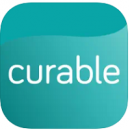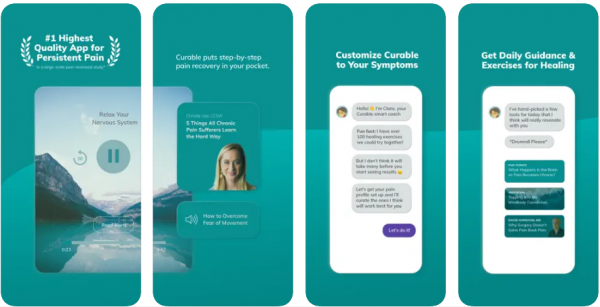| Curable app | By Curable Health |
 |
Features
|
| Clinical review |
|
| Security and privacy | Does the app:
Read more about safety and security when using apps. Brochures: |
| Cost | The basic version is free, but there is a paid upgrade version. Learn more about app charges |
| Advertisements | This app contains no ads. |
| How to get the app |
Low or no data? Visit zero.govt.nz, scroll down the page then click on our logo to return to our site and browse for free.
Curable app
Curable app
- An app to deliver step-by-step education, information and practical strategies to address chronic pain.

Curable is an app used to deliver step-by-step education, information and practical strategies to address chronic pain. The app uses a virtual coach with a narrative style and takes a user through the process to adequately understand pain, the reasons for it, the mechanisms behind it, and how we can work to address it. It includes practical exercises to address pain.
The app is aimed at individuals with chronic pain and healthcare providers who want to use this app to help with educating their patients who have chronic pain. For the complete app description, go to Google Play(external link) , iTunes(external link) and the app website(external link) or for a more detailed review, see reviews below.

| PROS | CONS |
|---|---|
|
✔ The style of this app is quite user-friendly. It uses a “virtual coach” which is displayed as if someone is messaging you and giving some practical solutions. The language used is easy to understand, and it presents the information in an easy-to-understand manner. |
✘ The app does have what some will call a significant cost associated with it (renewing annual subscription of $118 per year NZD).
|
Clinical review
Free version![]()
Reviewer: Chris Lawrence, Community Physiotherapist
Date of review: June 2023
Version: 5.0.6
Platform: Android (works with Android 5.1 and up)
Comments: Overall, Curable is an excellent app. It addresses the challenging topic of pain education and explains information in an easy-to-understand manner. The education is well-backed by science and research. Users of the app could be confident that they are receiving accurate medical information.
The style that information is presented in is quite effective. It means that a user can have choice in terms of how much information they go through at once, and their preferred style for taking this on.
The price point for this app may be prohibitive for some. However, for a user that may have experienced pain for some time will likely get a lot of benefit from using the app and may feel that this is a worthwhile investment of money, especially when compared to the prices of private appointments.
For health professionals and therapists this could be a good adjunct to therapy, and the additional downloadable resources are likely to be helpful for display in the clinic.
It is likely that being able to take on information around pain management at a user’s own speed, and being able to revisit this information when they need to, can be an excellent approach for understand chronic pain and pain management.
Safety concerns: None. The information through the app is presented in a very safe way, with clear warnings around application. The app is protected in a way that a user needs to go through the education modules before they can jump to exercises, which ensures that a user would go through the information in a safe manner.
New Zealand relevance: Yes – this app provides excellent practical advice that would be very applicable to a NZ context.
Clinical review
Free version![]()
Paid version![]()
Reviewer: Jeremy Steinberg, GP, FRNZCGP
Date of review: April 2019
Review: Curable is an app designed to help people with chronic pain by addressing the psychology of pain. A virtual therapist guides you through audio lectures and activities and adjusts recommendations based on your responses.
The app would be particularly helpful to those with a history of childhood trauma or stress as there is a strong focus on this area.
The app uses the Mind-body approach or Emotional awareness and expressive therapy (EAET) which encourages people to experience their negative emotions and create new corrective experiences. There is some limited research to support the use of this approach, but it is not as mature as other therapies such as cognitive behavioural therapy (CBT) and acceptance and commitment therapy (ACT).
However, there are many aspects of EAET that overlap with components in other therapies with a strong evidence base such as mindfulness and re-engagement with activity.
The free version has several hours of content with 13 free introductory pain education lessons and a limited number of other activities.
To access most of the content, users have to pay a monthly subscription (NZD $22 per month). The paid version is essentially divided into four sections: pain education, brain training, meditation and expressive writing. After each exercise, you choose one of these four broad topics, and then the virtual therapist chooses a specific activity for you. This helps to remove so-called “choice paralysis”
The expressive writing section is a two-part process. You first complete stream of consciousness writing about a specific topic such as about a traumatic event in your childhood and adult life. This is in order to uncover suppressed thoughts and feelings. The next step is finding compassion for the feelings, rationally looking at what you have written, and analysing your own personality traits and dispositional factors. You rip up your paper when done.
The brain training section covers practical tools to help with pain. The tools include present moment awareness, progressive relaxation, square/box breathing, panic busting with touch, setting boundaries, incorporating joy and play, gratitude, rubber band trick, breaking habits, visualisation, self-care, and multiple exercises on cognitive reframing of distorted thinking (CBT).
The meditation section consists of several guided meditations. The user chooses what duration of guided meditation they want. The topics include present moment awareness, body scan, forgiveness, self-compassion, boundary setting, and surrender.
The education section follows on from the free lectures and includes further audio lectures on forgiveness, low self-esteem, catastrophising, inner critic, anxiety, stress from pain, self-compassion, pessimism, relapses, major life events, triggers, expectations, and depression.
The panic mode is a particularly nice feature. If the user is experiencing severe pain, there are emergency tools to try and help – meditation, visualization, identifying emotions, and pep talk.
The patient interviews could potentially be motivating for some people, and there are a variety to choose from covering different pain conditions.
The two areas of caution that users should be aware of are:
- Writing about previous traumas can bring about some short-term distress.
- The app downplays physical pain generators (such as a prolapsed lumbar disc), which may or may not be appropriate depending on the person.
Overall, curable is a comprehensive pain education tool with a focus on the psychology of pain and emotions. I would highly recommend it to anyone with chronic pain who would like to try tackle the psychology of their pain. There are dozens of hours of content and activities that would keep someone busy for at least 2-3 months if they were diligent.
Safety concerns: Writing about trauma can cause a short-term increase in distress.
References
- Devan H, Farmery D, Peebles L, Grainger R. Evaluation of Self-Management Support Functions in Apps for People With Persistent Pain: Systematic Review.(external link) JMIR Mhealth Uhealth. 2019 Feb 12;7(2)
- Rahman QA, Janmohamed T, Pirbaglou M, et al. Patterns of User Engagement With the Mobile App, Manage My Pain: Results of a Data Mining Investigation.(external link) JMIR Mhealth Uhealth. 2017 Jul 12;5(7):e96.
- Chaudhry BM. No gain without pain: using pain tracking mobile Apps(external link). Mhealth. 2016 Jul 4;2:27.
- Lalloo C, Jibb LA, Rivera J, et al. "There's a Pain App for That": Review of Patient-targeted Smartphone Applications for Pain Management.(external link) Clin J Pain. 2015 Jun;31(6):557-63.
- Wallace LS, Dhingra LK. A systematic review of smartphone applications for chronic pain available for download in the United States.(external link) J Opioid Manag. 2014 Jan-Feb;10(1):63-8.
|
Disclaimer: The NZ Health App Library is a free consumer service to help you decide whether a health app would be suitable for you. Our review process is independent. We have no relationship with the app developers or companies and no responsibility for the service they provide. This means that if you have an issue with one of the apps we have reviewed, you will need to contact the app developer or company directly. |
Credits: Healthify editorial team. Healthify is brought to you by Health Navigator Charitable Trust.





